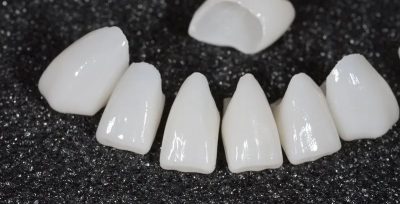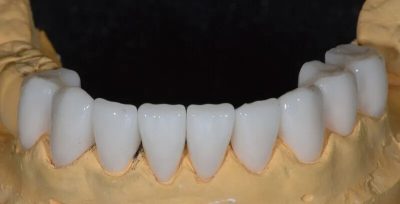Prosthetics
Dentures are a set of actions aimed at replacing one or more missing teeth or part of a missing tooth with an artificial material. Dentures restore the function, appearance, colour and comfort of teeth.
There are several types of dentures:
- Dental onlays, inlays – “large fillings” that replace large tooth defects (made in a laboratory after an impression of the tooth is taken by a dentist and fixed on the tooth surface). Materials: composite or ceramic.
- Dental crown – a “dental micite” or shell that is placed over the prepared (ground down) dental stem in the case of a damaged crown. It restores the shape, colour and strength of the tooth. The range of materials is large-plastic, composite, metal, ceramic and zirconia. (see more)
- Implant-supported dental crown – the tooth “mic” is made on an implant placed in the jawbone and screwed or cemented onto it. The shape and colour are indistinguishable from a natural tooth and are comfortable.
- Dental bridge – crowns connected to each other and the abutment is on either side of the missing tooth.
- Dental plate – a plastic prosthesis that replaces all missing teeth and rests on the gums and remaining teeth.
- Arch denture – a plastic and metal combination dental plate that is more comfortable and stable.
- Total plate – a plastic denture made when there are no teeth. It is removable and, in case of poor fixation (usually in the mandible), can be fixed with different elements to the existing plate if at least 2 implants are placed (see more).
- In the ALL on 4 concept (e.g. in the lower jaw), 4 implants can be placed to create a non-removable bridge supported by 4 implants (see more). A titanium rod is fabricated on the implants, coated with a composite material or zirconia and screwed onto the implants located in the jawbone.
Frequently asked questions about prosthetics >>>

Dental crowns

Dental crowns on model
Prosthetics prices
| Plastic crown (made in the laboratory) | 130.00€ |
| Plastic crown (made in the dentist’s chair) | 60.00€ |
| PMMA temporary crown for long-term use of CAD-CAM system (max 2 years) | 210.00€ |
| Composite crown | 230.00€ |
| Ceramic-metal crown | 450.00€ |
| Cast metal crown | 260.00€ |
| Crown of zircon (full form) | 500.00€ |
| Ceramic-coated zircon crown | 555.00€ |
| Zircon crown on Megajen, ROOT, Neodent implant | 750.00€ |
| Zircon crown on Straumann, Prama or other premium implant with standard abutment (1 unit) | 850.00€ |
| Root inlay metal (per channel) | 100.00€ |
| Root inlet metal (for two channels) | 110.00€ |
| Root inlay with attachment for prosthesis fixation | 300.00€ |
| An incisor retainer or dental splint | 160.00€ |
| Removing a repeater | 70.00€ |
| Prototype crown | 40.00€ |
| Telescope crown | 450.00-600.00€ |
| Temporary crown on implant | 280.00-320.00€ |
Removable prostheses (acrylic, composite base)
| Single-tooth plastic prosthesis | 190.00€ |
| Valplast single tooth (elstical) plate | 370.00€ |
| Plastic denture (up to 6 teeth) | 360.00€ |
| Plastic denture (over 6 teeth) | 390.00€ |
| Plastic total denture in the maxilla or mandible | 650.00€ |
| Plastic prosthesis with soft base | 650.00€ |
| Valplast flexible prosthesis | 630.00-795.00€ |
| Arched prosthesis | 795.00€ |
| Arched prosthesis with milling and attachments | 990.00€ |
Repairs (tooth plates)
| Plate repair (tear, fracture) | 90.00€ |
| Plate reparation (attaching a tooth, mesh or bent clamp) | 90.00€ |
| Same-day surcharge for repairs | double fee at list price |
| Reperforation on thermoplastic prosthesis | 180.00€ |
| Rebasing (lining) | 100.00€ |





